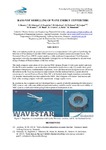RANS-VOF Modelling of Wave Energy Converters
| dc.contributor.author | Ransley, E | |
| dc.contributor.author | Göteman, M | |
| dc.contributor.author | Engström, J | |
| dc.contributor.author | Jakobsen, M | |
| dc.contributor.author | Eriksson, M | |
| dc.contributor.author | Leijon, M | |
| dc.contributor.author | Kramer, M | |
| dc.contributor.author | Hann, Martyn | |
| dc.contributor.author | Greaves, Deborah | |
| dc.date.accessioned | 2019-04-04T09:27:36Z | |
| dc.date.available | 2019-04-04T09:27:36Z | |
| dc.date.issued | 2015-06-16 | |
| dc.identifier.uri | http://hdl.handle.net/10026.1/13612 | |
| dc.description.abstract |
This cross-industry/academic project aims to develop a computational tool capable of predicting the behavior of Wave Energy Converter (WEC) and mooring coupled systems in extreme waves. The Numerical Wave Tank (NWT) created employs a fully nonlinear Computational Fluid Dynamics approach to solve the incompressible Reynolds-Averaged Navier-Stokes equations for air and water using a Volume of Fluid treatment of the free surface. The study compares simulations of two existing WEC designs (Figure 1) with scale-model tank tests. For the Wavestar machine, a point-absorber constrained to pitch motion only [1], results show good agreement with physical measurements of pressure, force and float motion in regular waves. However, the solution in the wake region requires improvement. For the Seabased device, a point-absorber consisting of a moored float and Power Take-Off with limited stroke length, translator and endstop [2], bespoke functionality has been added to the NWT. The 6 Degrees of Freedom float motion and load in the mooring compare well with experiments in large regular waves. In conclusion, the computational tool developed here is capable of reliably predicting the behaviour of WEC systems and, with some additional parameterisation, could be used to assess the survivability of WEC systems at full-scale before going to the expense of deployment at sea. | |
| dc.language.iso | en | |
| dc.title | RANS-VOF Modelling of Wave Energy Converters | |
| dc.type | conference | |
| plymouth.date-start | 2015-06-16 | |
| plymouth.date-finish | 2015-06-17 | |
| plymouth.conference-name | in Proceedings of the 2nd PRIMaRE Conference | |
| plymouth.organisational-group | /Plymouth | |
| plymouth.organisational-group | /Plymouth/Faculty of Science and Engineering | |
| plymouth.organisational-group | /Plymouth/PRIMaRE Publications | |
| plymouth.organisational-group | /Plymouth/REF 2021 Researchers by UoA | |
| plymouth.organisational-group | /Plymouth/REF 2021 Researchers by UoA/UoA12 Engineering | |
| plymouth.organisational-group | /Plymouth/Research Groups | |
| plymouth.organisational-group | /Plymouth/Research Groups/Marine Institute | |
| plymouth.organisational-group | /Plymouth/Users by role | |
| plymouth.organisational-group | /Plymouth/Users by role/Academics | |
| plymouth.organisational-group | /Plymouth/Users by role/Researchers in ResearchFish submission | |
| dc.publisher.place | Penryn, UK | |
| dcterms.dateAccepted | 2015-06-16 | |
| dc.rights.embargoperiod | Not known | |
| rioxxterms.licenseref.uri | http://www.rioxx.net/licenses/all-rights-reserved | |
| rioxxterms.licenseref.startdate | 2015-06-16 | |
| rioxxterms.type | Conference Paper/Proceeding/Abstract |


